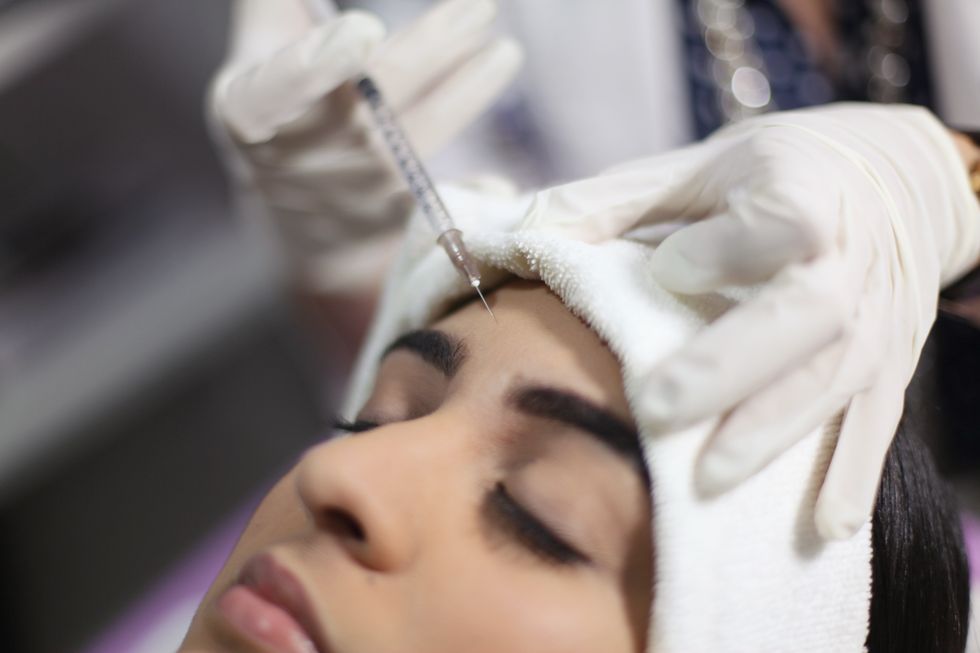In the Shondaland series The Magic of Moving Forward, we’re bringing you forward-thinking stories that illustrate how moving on from something is a way to level up. From women finding joy by throwing themselves divorce parties to vulnerable tales about entering new friendships and relationships, to discovering pleasure in life after giving up a bad habit — there’s no one way to flip the page and find happiness all over again.
Despite the pressure to look younger, curvier, and sexier, Blac Chyna decided to go in an entirely different direction. The influencer and former reality star recently announced that she was going back to her given name, Angela White, and dissolving her facial fillers as part of a larger transformation.
“I just wasn’t happy [with] the way I looked,” she recently told ABC News. While there’s no stampede of other social media stars announcing that they are running to their doctor’s offices to have their procedures reversed or letting them lapse, an increasing number of patients are deciding that they’re done with fillers.
It seems not everyone has to end up on Botched to reconsider their results with Botox, Restylane, Juvéderm, and other injectable cosmetic treatments. For some patients, the results are simply not what they expected or desired, and others no longer wish to keep up with ongoing injections.
Sarah Joseph, a 32-year-old marketing manager, says the investment and inconvenience weren’t paying off. “The injectables didn’t improve my appearance in a way that made me feel comfortable or confident,” she says. “The changes were only subtle, and the discomfort wasn’t worth it. I started looking unnatural, and I wasn’t thrilled with the results.” For now, she says she’s been content with a filler-free skincare routine.
For 49-year-old gallery owner Alia Madden, the paralyzing side effects didn’t feel right to her body and the way she expresses herself. “I was happy with it at first, but it started annoying me that my face couldn’t move like normal,” she says. “I have a fairly expressive face, so it was weird not being able to do things like lift my eyebrows. Over time, I really didn’t like it and was relieved when it wore off. I decided that being able to move my eyebrows was more important than not having lines on my forehead.”
Madden adds that giving up injectables was another way of fighting ageism and being more comfortable in her own skin. “As I’ve gotten older,” she explains, “I’ve gotten a little more radicalized and have questioned why something as innocuous as lines on your face is seen as a problem you need to pay money to fix.”
To inject or not?
To avoid disappointment in the first place, doctors advise potential patients to set realistic expectations and be diligent about selecting the right practitioners if they continue with treatments. They should work closely together with the team providing the injections so they don’t feel pressured into adding too much too quickly, resulting in an overfilled or motionless look.
Dr. Melissa Doft, a board-certified plastic surgeon, recommends starting small and being patient. “If it is the first time, I usually start slow,” she says. “I will add less toxin or filler than I may normally if the patient is nervous.” She says that some recipients experience bruising or swelling that can throw off the initial look. Doctors also point out that what you see at first is not necessarily what you will get. Botox injections can take five to seven days to take effect, and fillers can take up to three weeks for full results.
“I always preface that filler affects each body differently,” New York-based plastic surgeon Dr. Konstantin Vasyukevich says. “Sometimes, it may appear there is swelling or perhaps an asymmetrical look, but before you make final judgments, you need to wait two weeks to fully let the filler settle in to your body.”
Vasyukevich notes that the recovery period is when people can be the most dissatisfied. “Sometimes, people get accustomed to the swollen look and are disappointed when the face heals and the swelling goes down,” he acknowledges. If you don’t like the results after the initial adjustment period, you still have options.
For anything that feels like an emergency, immediately return to the doctor to resolve the issue. “If you are not happy with your results, it is easy to get your filler dissolved,” Vasyukevich says. “The process takes about 10 minutes, and the filler should dissolve fully within a couple of days.”
If you feel like you can temporarily live with it, do nothing. The results will merely fade over time. Typically, there is no long-term harm done to the skin or underlying muscles. “Your wrinkles will naturally reappear if you stop treatments but not at a drastic or intensified rate,” Vasyukevich explains. Usually, there is no physical downside to not keeping up with injections.
A new trend?
Abandoning dermal fillers could be catching on. The American Society of Plastic Surgeons estimated that Botox use was down 13 percent, and fillers were down 11 percent, in 2020, but that could entirely be the result of the pandemic.
In the United States, the medical aesthetics industry actually surpassed $16.7 billion in 2022. The industry’s advancements don’t seem to be slowing down, as a range of new injectable treatments are on the horizon, such as Restylane Kysse for lips and Juvéderm Volux for jawlines, which are in the pipeline for FDA approval.
Overall, most patients report being satisfied with the results of injectables, and the risks of trying them remain low. If fillers don’t provide a patient with a boost, the beauty of nonpermanent procedures — or downside, depending on your point of view — is that they don’t last forever.
Ilise S. Carter is a New York-based writer who has contributed to The New York Times, Allure, and The Wall Street Journal. She is the author of The Red Menace: How Lipstick Changed the Face of American History.
Get Shondaland directly in your inbox: SUBSCRIBE TODAY
















